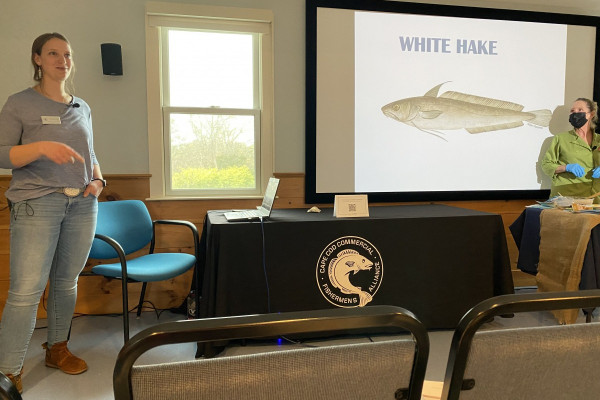
Outreach coordinator Stephanie Sykes talks hake while chef Lisa Whelan looks on.
By Doreen Leggett
Chef Lisa Whelan of Dancing Spoons Catering stood before a crowd of about 70 people, bottles of honey, ginger, and apple cider vinegar arrayed before her and a thick piece of cornmeal-encrusted fish browning on the burner.
“This is a good substitute for cod – flaky, white,” said Whelan as she readied a fillet of white hake for its bed of broccoli slaw atop a cookie-sized fajita.
Melissa Sanderson, chief operating officer of the Cape Cod Commercial Fishermen’s Alliance, agreed white hake was a perfect replacement for the more well-known cod – “unless you want to eat imported fish from elsewhere, which we don’t encourage.”
Whelan and Sanderson were at the first Meet the Fleet of the season in May, an event designed to introduce people to great-tasting local fish cooked by noted local chefs, joined by fishermen who catch it.
In the decade since Meet the Fleet was launched by the Fishermen’s Alliance, this was the first time white hake had been served, said Sanderson.
Sanderson explained to the crowd gathered in the barn of the Fishermen’s Alliance that low numbers of cod in recent years has pushed fishermen to catch other species, such as dogfish, skate, and monkfish.
This year fishermen got even more bad news on the Cape’s namesake.
“The cod quota could be cut by 78 percent,” Sanderson said.
Quota is the amount of fish that can be harvested, based on an assessment of how much of the stock is in the water. So the cut is severe.
Stephanie Sykes, who was emceeing the event along with Sanderson, helps run the Fisheries Trust at the Fishermen’s Alliance, which leases quota to fishermen at affordable prices. That day she had gotten a call from a captain who wanted her to set aside some hake quota because he had done his homework and was getting good at catching it. He was folding it into his business plan.
Eric Hesse, captain of the Tenacious II and chair of the board of directors of the Fishermen’s Alliance, had caught some of the hake that Whelan was plating up in the kitchen. He uses a technique called longlining, catching fish on individual hooks rather than in broad nets.
Sykes explained he caught this hake in the Gulf of Maine as part of a cooperative research effort, which added longlining into a Northeast Fisheries Science Center survey to see if fish were being missed by the government’s trawl, which doesn’t perform well in rocky areas.
Turns out the government’s survey was missing hake on the rocky bottom, which will play into management and quota decisions.
Captain Mike Anderson said hake has been around as long as he can remember – he has been fishing for close to 50 years – but never in huge amounts. When he was fishing hard, cod was abundant, hake secondary.
White hake (there is also red hake and silver hake – which isn’t a hake at all, actually whiting) are related to cod. They look more like an eel with a long fin on their back, usually found in deep water.
“They have great big eyes,” Anderson said.
The combination of the bug eyes, the long fin and the size – they can be 50 pounds – can invoke the idea of a sea monster.
Anderson said there was a time that he got hooks stuck in a long black, twisting mass that was unlike any fish he had ever seen. He slowly brought it up expecting something like a mini-Lochness.
“It was a telephone pole, with five hake caught up,” he said to laughter.
The crowd was interested in how longlining worked.
Anderson walked them through the process and the various tides (set on a slack tide and haul on a fair tide) and there were several in the audience who said the complexity was beyond them.
There was also Anderson’s story of selling cusk, which looks a lot hake, to a fish buyer decades ago. Selling may be the wrong word.
When Anderson got paid for all his catch he noticed a 0 for cusk and the fish buyer said he couldn’t sell it. So Anderson asked for it back. The fish buyer said he did sell it, but at a loss because he had to ice it and put it in a box.
Anderson just shook his head, to laughter.
Several in the audience had tried hake in recent weeks. Susan Moran, who loved it, asked the best way to skin the fillet.
Whelan said that she can always ask the fish market, but Sanderson, who filleted the hake for the event, gave this tip:
“Place the fillet skin face-down on your cutting board; grab the tail end of the fillet – dig your thumb in- and insert your knife into the fillet just after your thumb at a 45 degree-angle- stop before you get to the skin. Then scrape and wiggle the knife towards the thick end of the fillet while pulling the skin in the opposite direction.”
Hake for the evening had also been donated by Red’s Best, which works at the Chatham Fish Pier to offload catch and has a store and processing facility in Boston.
Audience member Jo Ann Castellano gets another tasty cod substitute from Red’s – skate – shipped to her door in Brewster.
“Red’s Best is the place to get it because it is from the Cape,” said Sykes.
This event was sponsored by longtime sponsor Gibson Sotheby International Realty, Chatham Bars Inn and Quahog Republic brewery. The Fishermen’s Alliance recently received a Saltonstall-Kennedy grant to expand its Meet the Fleet series and add a video component.
